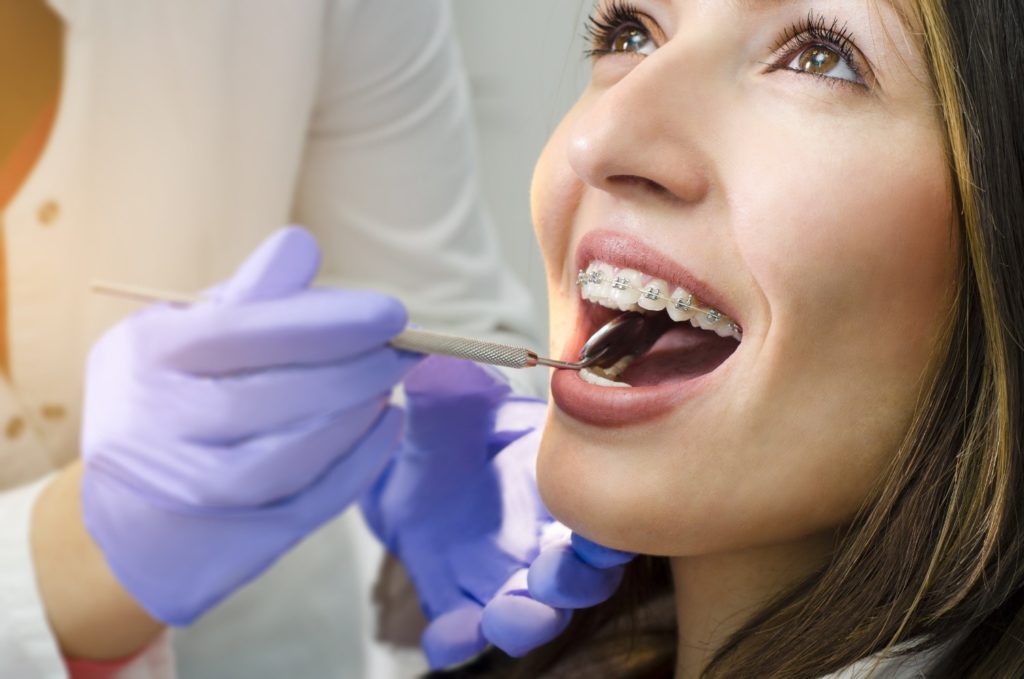Orthodontics as a profession is always in pursuit of the perfect smile. Orthodontists like Dr. Frey are continually learning more about what goes into creating a beautifully aligned, esthetically pleasing, fully functioning smile for patients. In recent years, there has been a shift within orthodontics, with less emphasis on the dental and skeletal components and more focus on the soft tissue aspects. This allows orthodontists to create more natural esthetics for a patient by giving careful consideration to the entire package, as it were; taking into account the diagnosis and traditional treatment planning while also recognizing and working with the dynamic relationship between the teeth and the surrounding soft tissues during and after orthodontic correction.
 The aesthetics of a smile
The aesthetics of a smile
The term esthetics is derived from the Greek word for “perception”. For the purposes of orthodontics, this idea can be divided into two notions. Objective esthetics imply that the object, in this case, a patient’s smile, possesses properties that make it undeniably worthy of praise and admiration. Subjective esthetics are more personally driven, related to the tastes of the person considering it. Contemporary techniques in orthodontics strive for objective esthetics when creating customized treatment plans, aiming to bring unity, form, structure, balance, color, function, and dentition display to the entirety of the orofacial complex. It is also important, however, to consider the subjective beauty of a smile according to the preferences of both the orthodontist as well as the patients themselves, thus enhancing the overall cosmetic value of the treatment.
Vertical positioning of the central incisors
A person’s smile is the most dominant component of facial esthetics. Once we realize the importance of the smile in that context, we can easily see how one’s perception of their own smile, coupled with the perceived perception of other people, can contribute either positively or negatively to an individual’s self-esteem and sense of well-being. Every orthodontist has experienced the transformation of a patient both physically and emotionally by successful orthodontic treatment! When special attention is given to esthetic planning in conjunction with treatment, it must begin with the vertical position of the central incisors, which are the key elements of any smile.
Our current beauty standards associate greater maxillary incisor exposure when smiling and at rest with beauty, joviality, and youthfulness. In order to increase the visibility of maxillary incisors and achieve the ideal incisal contour design, orthodontists may use a number of strategies, such as changing the height of the bracket positioning, orthodontic arch bends, or in the case of Dr. Frey, SAP bracket positioning that incorporates Vertical Incisor Position (VIP.)
SAP and VIP for enhanced results
SAP bracket positioning is Smile Arc Protection positioning. Essentially, this is a goal esthetic position for the incisal edges of the maxillary teeth. The presence of the Smile Arc is based on the Curve of Smee, the Occlusal Plane Angle, and the Vertical Incisor Position. When Dr. Frey began to focus on the importance of visible incisors in the most successful smiles, he instinctively understood that the component of the Smile Arc orthodontists have the most control over is the Vertical Incisor Position. To capitalize on that, he created a new convention to describe the vertical position of the upper incisors – the VIP. His goal in doing so is to aid in the assessment of increasing display and creating a beautiful smile arc consonance.
The VIP classification system is simple. Patients are divided into zones based on the amount of incisor and gingival display.
- Black Zone: patients who have insufficient incisor display
- Red Zone: patients who have excessive gingival display
- Green Zone: patients who have the ideal full display of central incisors
To determine into which zone a particular patient falls, Dr. Frey will evaluate them face-to-face during a clinical exam, while encouraging a full, posed smile from them. Once the color zone has been established, a millimeter measurement is taken to designate how far the maxillary gingival and incisor margins are from their goal position. Most patients are unaware of any insufficiency in their incisor display, or at least are unable to articulate it. Many are surprised to learn there is a technical term for why they have never felt completely comfortable with their smile! Once they have been made aware of their VIP, almost every patient will want to improve it. Why? Because a full incisor display will always look better on, and to, everyone.
 Improving your overall smile with innovation at Frey Orthodontics
Improving your overall smile with innovation at Frey Orthodontics
The expectations of consumers, in general, are at an all-time high, and orthodontics is no exception. Patients want optimal results with short treatment times and variety of orthodontic options to choose from. By taking their cosmetic concerns seriously, and making the esthetics of their smile a priority, Frey Orthodontics are able to meet and exceed those expectations. Incorporating SAP and VIP into his practice, along with a willingness to learn “active early” mechanics and modified bracket positioning, has set Dr. Frey apart from other orthodontists. He is routinely able to produce better results for patients in a shorter time and with fewer appointments. To learn more about how SAP, VIP, and an innovative orthodontics like Dr. Frey can create a truly stunning smile for you, get in touch with us today to schedule a consultation.

